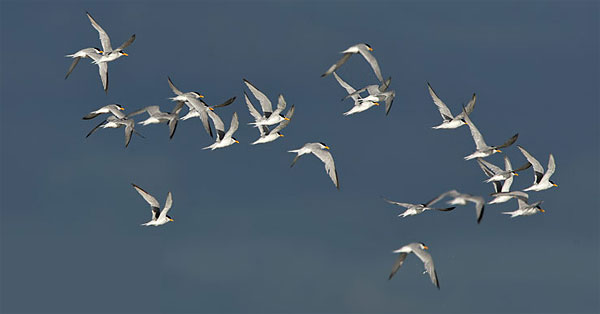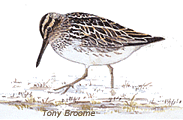
June 2011 Newsletter
Little Tern Colony - Gronant.
May Bird News.
Forthcoming Events.
Latest Newsletter.
Gronant Update June 24th - Little Terns doing well but currently some problems with a kestrel taking some chicks and there is a shortage of voluntary wardens Any Help Would Be Appreciated.
Little Tern colonies are always very variable in their productivity, and you can see from the graph that Gronant is a good example of this. So after three years (2007 to 2009) when the numbers of pairs and successfully fledged young hardly changed, I felt that 2010 was either going to be a record breaking year, or a complete disaster! I couldn't really see the latter so I was optimistic, and that is how it turned out with 114 pairs producing 216 fledged young, previous records were 111 pairs (2009) and 190 young (2003).
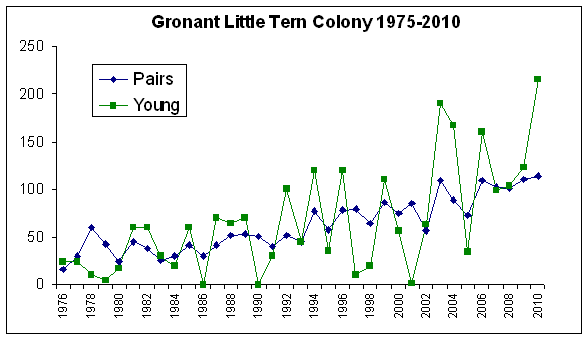
2010 was one of those years when everything went right - good weather, very little predation, an enthusiastic wardening team and plenty of Little Terns. Two things were particularly crucial - good weather both when the terns first arrived and when the eggs were hatching, and the reliability of the electric net fencing which kept the foxes away.
Equally important are the wardens who
keep the crows and kestrels from taking eggs and chicks, we also ensure
the colony is undisturbed by people and dogs and also chat to any
visitors telling them all about the Little Terns. Much of this
wardening is done by volunteers so if you can help please do. Email me
if you are interested and I can give you further details and put you in
touch with the contract wardens:
![]()
For more information about Gronant generally there is quite a detailed site guide in the June 2009 newsletter.
Reference: Denbighshire County Council, Little Tern Report, GRONANT 2009, Emma Thomas, Owen Chamberlain and Sally Conyers.
Richard Smith (Gronant Voluntary Warden).
May Bird News
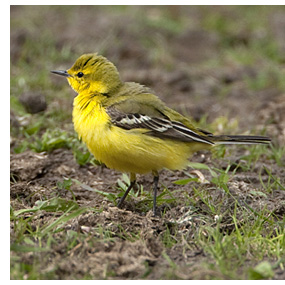 They
were like bright yellow
leaves blown by a swirling wind. Sorry to go all poetical on you but
that's what I thought whilst watching a flock of 25 Yellow Wagtails in
the horse paddocks by Leasowe
Lighthouse
on the 5th. Earlier in the day over 40 had been reported here and by
the evening numbers had built up to 58 - these must be the highest
numbers here for well over 20 years where anything over 10 is usually
considered exceptional. What intrigued me was the way the large flock
were behaving, very restless, constantly on the move and swirling
around in flight in contrast to the behaviour of most Yellow Wagtails
here which usually just stay on the ground busy feeding. It was nice to
see so many females in the flock, looking as beautiful as the males but
much more of a pale primrose colour as opposed to the males' bright
buttercup yellow. Photo by Matt Thomas.
They
were like bright yellow
leaves blown by a swirling wind. Sorry to go all poetical on you but
that's what I thought whilst watching a flock of 25 Yellow Wagtails in
the horse paddocks by Leasowe
Lighthouse
on the 5th. Earlier in the day over 40 had been reported here and by
the evening numbers had built up to 58 - these must be the highest
numbers here for well over 20 years where anything over 10 is usually
considered exceptional. What intrigued me was the way the large flock
were behaving, very restless, constantly on the move and swirling
around in flight in contrast to the behaviour of most Yellow Wagtails
here which usually just stay on the ground busy feeding. It was nice to
see so many females in the flock, looking as beautiful as the males but
much more of a pale primrose colour as opposed to the males' bright
buttercup yellow. Photo by Matt Thomas.
I have to say that I thought after such a good April for spring migration things would go really quiet in May - but this was certainly not the case. The Leasowe Lighthouse area was a hot spot again with good sightings reported from here on most days of the month - apart from the Yellow Wagtails mentioned above highlights were: a Ring Ouzel (3rd), 26 Wheatear and 6 Whinchat (4th), a Short-eared Owl (7th), 52 Great Crested Grebe (9th), a Red-rumped Swallow (10th) which is the fourth year in a row this species has turned up, 2 Hobby (18th) and single Cuckoos on both 22nd and 24th. Not to be out done Point of Ayr had 16 Whinchat, 5 Yellow Wagtail, 65 Wheatear, 2 Tree Pipit and 6 Whimbrel on the 2nd.
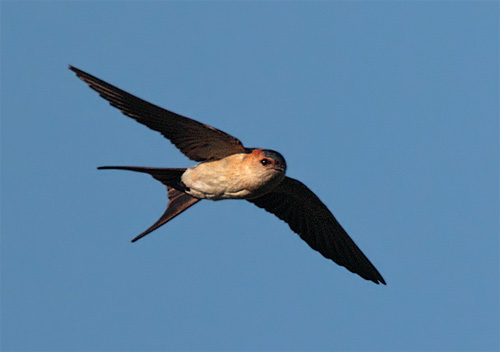
It was a good May for Hilbre; the month started well with a huge fall of at least 150 Willow Warblers on the 2nd, remarkably 73 of these were caught and ringed. Other highlights were 2,000 Swallows counted flying through on the 6th and a Cuckoo was on the island on the 23rd.
The weather changed after mid-month and several days of strong westerlies set in. I've never seen so many Gannets off Hoylake than there were on the 22nd, I counted 266 in one sweep of the 'scope and someone earlier on had 275 - but the total for that day must have been well over double that as they were steadily coming in from Formby Point and going off towards North Wales. 700 past Hilbre the following day was one of the largest counts ever made from there, a further 200 were counted on the 24th followed by two counts of at least 300 later on in the month. Manx Shearwaters also were in good numbers with 325 past Hoylake on the 22nd and 300 past Hilbre on the 23rd the two highest counts. Several Arctic Skuas and a couple of Great Skuas were also recorded.
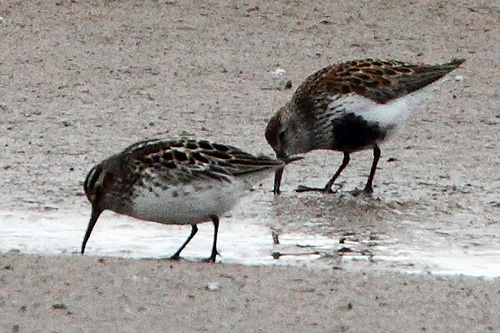
Those who read my article last July on Knot and Dunlin on NW estuaries will know that normally we get very few of either here on the Dee Estuary/North Wirral in May, in contrast to the nearby Ribble Estuary which routinely gets many thousands. I was therefore surprised, but pleased, to note over 5,000 Dunlin at Hoylake on the 13th. These high numbers continued and had reached a maximum of 15,000 by the 15th. 1,000 Ringed Plover on the 19th was also a high count for May, numbers like this for both species haven't been recorded here in May since the mid-1970s. Searching through these flocks was certainly well rewarded when a Broad-billed Sandpiper was spotted on the 15th, which stayed several days although somewhat difficult to see. This species, which normally migrates through eastern Europe, has only been recorded once before in the Dee Estuary area with one at Inner Marsh Farm in 1990, also in May. A Little Stint and at least one Curlew Sandpiper were also seen amongst the Dunlin.
Other rarities this month include a Wood Sandpiper at Gilroy Nature Park and a Spoonbill at Inner Marsh Farm. Two Ospreys were recorded this month, one at Point of Ayr on the 2nd and one eating a fish on the shore at Hoylake on the 19th. The highest Whimbrel counts were 25 on the Clwyd side of Burton Marsh and 33 at Hilbre on the 7th.
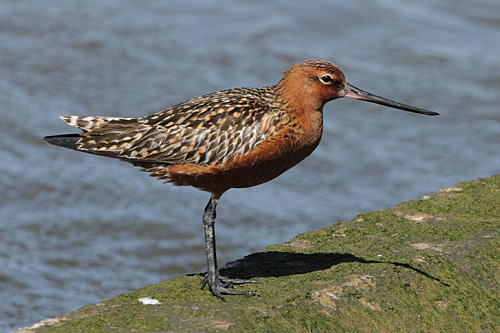
Richard Smith.
What to expect in June
I find June an intriguing month as we can still get spring migrants passing through early in the month, mostly waders, yet as early as mid-month birds are returning to the estuary after breeding. At the same time there are plenty of seabirds to see, especially terns, as well as good numbers of non-breeding waders.
Dunlin, Sanderling and Ringed Plover could still be coming through in the first few days of the month - in a hurry to get north! Look out for the summer plumaged Sanderling - some birders can get caught out by, what is to us, the unusual plumage, thinking they are looking at something much rarer!.
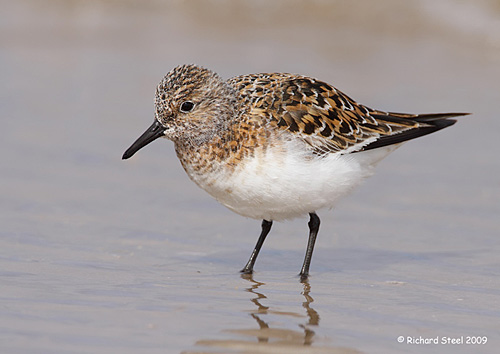
We will also get non-breeding Black-tailed Godwits at Inner Marsh Farm, sometimes several hundred strong, and maybe a few Knot there as well. Occasionally we see hundreds of over-summering Knots on the estuary, although they rarely stay for long. The first of the post-breeding waders to return are usually Spotted Redshanks, and also Green Sandpipers and perhaps a Greenshank or two.
Gull numbers will build rapidly in the estuary towards the end of the month, the best place to see Mediterranean Gulls will be Hoylake and Heswall. The Little Tern colony at Gronant will be in full swing with the first chicks hatching, and there should be a few Sandwich Terns returning as well as Common Terns feeding off north Wirral. If we get a fresh westerly wind expect to see good numbers of Gannets and Manx Shearwaters, together with an Arctic Skua or two.
June is a good month for Hobbies, a species which is increasing in the area, and there is a good chance a wandering Spoonbill or two will turn up.
June Highest Spring Tides (Liverpool)
Also see Tides
page.
16th June, 12.12hrs (BST), 9.1m.
Forthcoming Events
Organised by the Wirral
Ranger Service , Flintshire Countryside Service and/or the
RSPB:
All these events and walks have bird interest, even those not
advertised specifically for birdwatching. No need to book for these
events unless specified - please check below.
Also see 2011 Events Diary.
Join us at the Thurstaston Visitor Centre and see some of the magnificent birds of prey that have been rescued by Raptor Rescue, the UK’s foremost organisation for the rehabilitation of birds of prey. Information and displays throughout the day and goods on sale to help raise funds for this registered charity. For more info ring: 0151 648 4371
Thursday
16th June, 1:30pm - 3:00pm, Guided Walk over Caldy Hill.
Join the Ranger and discover all about the heathland and woodlands of
this area.
Meet at King’s Drive North car park, West Kirby end of Stapledon Wood
off Column Road.
For more info ring:
0151 677 7594.
Saturday
25th June, 2:00pm - 4:00pm, Barn Owls on Wirral.
Join the Wirral Barn Owl Group and discover more about the efforts
being made to conserve Barn Owls on Wirral.
Learn more about their habits and habitats including looking at the
food they eat.
Max number is 30. Booking essential.
Sorry no dogs.
Location is
Wirral Country Park, Thurstaston
Visitor
Centre. Please ring
0151 648 4371 to book.
Saturday
25th June, 7:30pm - 10:30pm, Barn Owl Talk and Evening Walk - Wirral
Country Park
Join the Rangers and Steve Harris from the Wirral Barn Owl Group for an
evening illustrated talk followed by a walk around the Thurstaston Visitor Centre
and along
the Wirral Way to (hopefully) see these lovely birds
quartering over the fields at dusk.
Sorry no dogs.
Maximum number is 25 and
Booking is essential.
Location is
Wirral Country Park, Thurstaston. Please ring
0151 648 4371 to book.
Friday
1st July, 9:00pm - 11:00pm, Bat and Owl Night - Royden Park.
Join the Rangers and discover the variety of Bats that thrive in our
woodlands, heathlands and meadows and listen to the call of the Tawny
Owl on this dusk/night walk.
Meet at the Rangers Office in Royden Park.
Sorry no dogs.
Please wear suitable footwear and bring a torch.
Booking essential (numbers limited to 18).
Ring
0151 648 4371 to book.
Tuesday
12th July, 1:30pm - 3:30pm, Guided Walk - Royden
Park.
Join the Ranger on a walk through the woodlands and meadows of Royden
Park.
Discover the history and wildlife of this park.
Meet at the Rangers Office Royden Park.
Please wear suitable footwear.
No need to book, for further info ring
0151 677 7594.
Saturday
16th July, 10:00am - 4:00pm, Wirral Wildlife - Royden Park.
and Sunday 17th July, 10:00am - 4:00pm.
Wirral Wildlife will have displays and information about their work and
events.
Also providing refreshments at the Tea Servery.
Meet at the Coach House at Royden Park.
Dogs on lead in Court Yard and Coach House please.
No need to book, for further info ring
0151 677 7594.
Wirral Wildlife is the Wirral Branch of Cheshire Wildlife Trust.
|
 |
The blank (UK) Birding Webring is a collection of quality birding web sites that are based in the United Kingdom. Visit the webring homepage for more information, or A complete list of all the sites in the webring is available by clicking here. previous site in ring : random site in ring : next site in ring |
